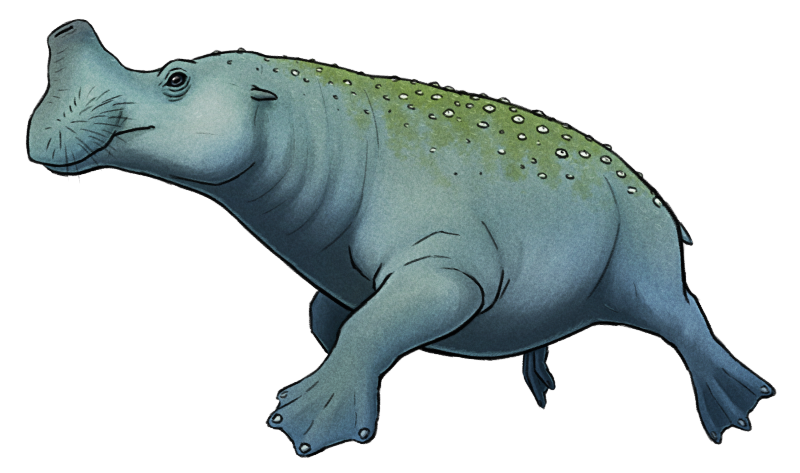Squeezing in one last bonus #Spectember post this year!
This one isn’t based on a specific prompt, but instead is a companion piece to a previous one.
While North American brontotheres were adapting to the spread of grasslands, some of their Asian cousins took a very different evolutionary path through the rest of the Cenozoic.
Some Asian brontotheres became aquatic hippo-like animals, with thick dense bones and flipper-like feet, moving into shallow coastal marine habitats and grazing on seagrasses. They developed a convergently similar lifestyle to desmostylians, fairly slow swimmers that “bottom-walked” along the seafloor to feed – but they weren’t in direct competition due to occupying more southerly waters in the west Pacific than the desmostylians, ranging from Southeast Asia down to Oceania.
Like other brontotheres they developed some strange nasal bones (similar to those of Embolotherium) forming a raised snorkel-like nose that allowed them to breathe without fully surfacing.
Many of these aquatic turret-nosed brontotheres eventually declined and went extinct during the Miocene and Pliocene, when cooling climates and dropping sea levels removed many of the shallow seagrass meadows they relied on, and dugongs began competing with them for the same limited food resources.
But one lineage hung on down in Australia.

The false bunyip (Scanduladorsum pumilum) is a diminutive aquatic brontothere, about the size of a pygmy hippo at 75cm tall (2’6″). It has reverted to a slightly more amphibious lifestyle compared to its almost fully-aquatic extinct relatives, and unusually for its kind it’s also primarily a freshwater species, living in lakes, rivers, and marshes – but migrating down to congregate in estuaries and shallow marine waters during the breeding season.
It spends daytime submerged underwater with just its “snorkel” nose poking above the surface, grazing on aquatic plants, then emerges onto land during the evening to supplement its diet with soft terrestrial leaves and fruits, moving with a slow sealion-like gait. Generally solitary, but not territorial, it communicates over long distances with other individuals of its kind using surprisingly loud booming calls, amplified by its large nasal cavity.
It also carries a commensal barnacle (Chelonibia brontes), descended from turtle barnacles. This species has evolved a unique tolerance for freshwater, allowing it to stay attached and alive on its host between trips back to more marine conditions.

Nice idea! Can I give out a speculative evolution idea please?